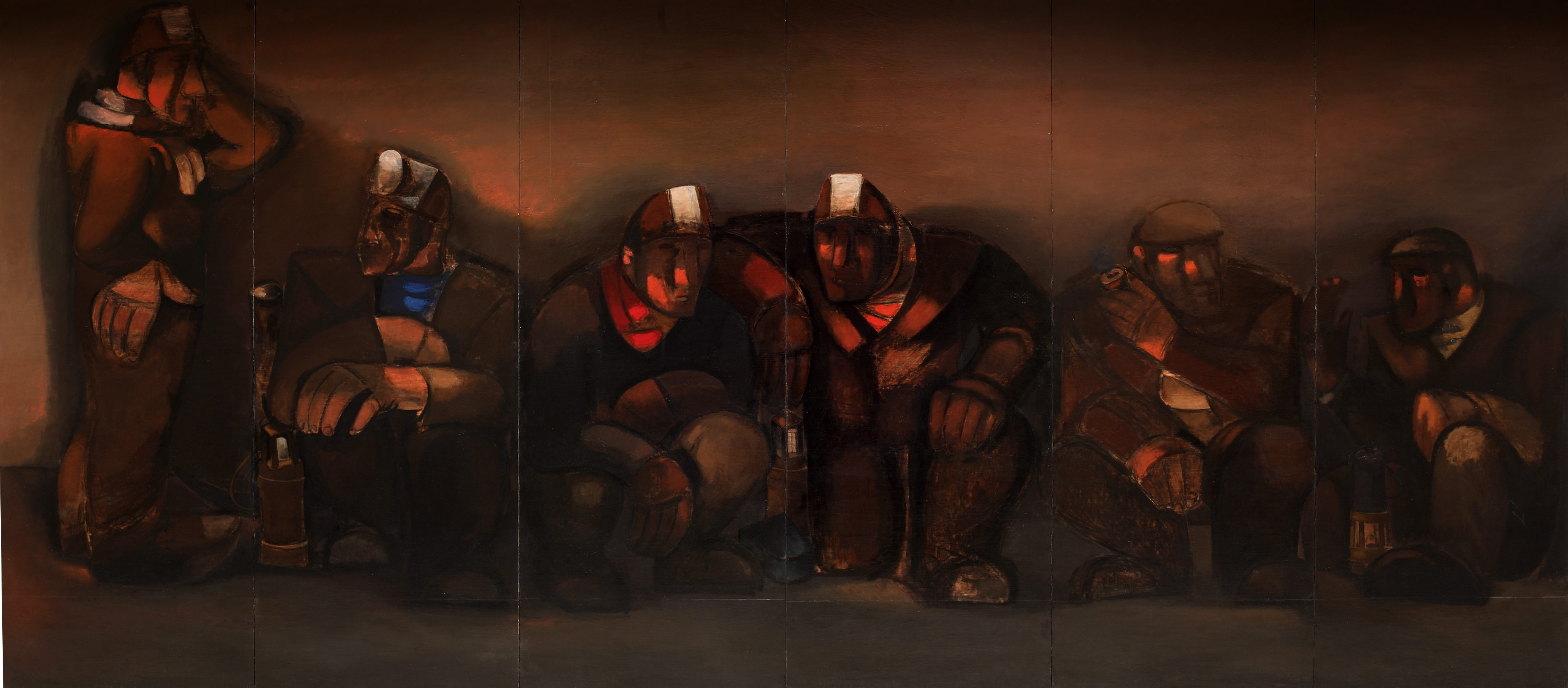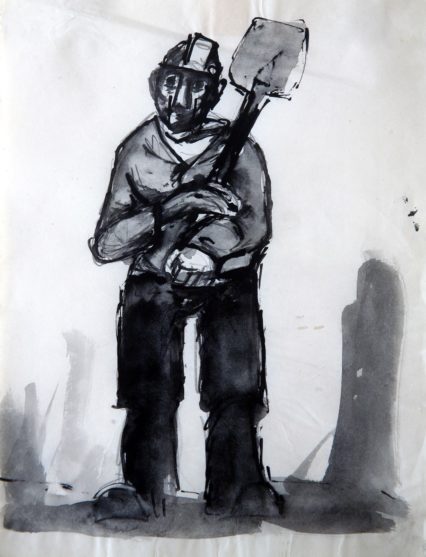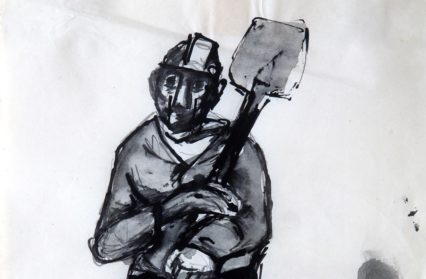
If you know your Zola, the works of Josef Herman seem to run side by side with passages such as this:
The miner finished his sentence with a gesture. His turn had come, the cage had reappeared, with its slick, effortless movement. He squatted down inside one of the tubs with his workmates, it plunged down again, then barely four minutes later, it surged back up again, ready to swallow down another load of men. For half an hour the pit gulped down these meals, in more or less greedy mouthfuls, depending on the depth of the level they were bound for, but without ever stopping, always hungry, its giant bowels capable of digesting a nation. It filled, and filled again, and the dark depths remained silent as the cage rose up from the void, silently opening its gaping jaws.
(Germinal, 1885)
The Frenchman’s central masterpiece of his 20 book Rougon-Macquart series may be separated from Herman’s Welsh paintings by both era and geography, but they are connected by a dystopian fire in the sky and a brutal tenderness of spirit. Zola would make his life’s work a study of the working life. Herman’s story is a little more serendipitous; that his Polish experience, that of both art education and existential threat in the 1930s, would find an outlet in the Wales of the 40s and 50s where he found refuge from the Nazis, is apparent in many aspects of his work. On display here, indulged in a chocolate-y light bestowed by Glynn Vivian’s curators, is a small but excellent cross-section of the work he produced when a resident of Ystradgynlais between 1945 and 1955.
Herman’s work of this period is often nothing short of stunning. His figures impose like gods, his landscapes have the depths of storybook worlds. And yet something out of the eye-line tethers them to the eerily familiar and real. “Mother and Child” (1952) is the most geometrically comforting of the images on display here, with its selection of lined-off browns and bulbed joints. We have a sympathetic face, a moment where Herman seeks to draw us in, but at its core is a twist on the Madonna and child theme – usually Herman keeps the viewer at arms length with his Easter Island heads and broad shoulders, but not here, not for this portrait of domestic interruption. The physique of Herman’s figures borrow a little from the exaggeration of Soviet poster art, and even more from Polynessian folk art. “Miners” (1951) is perhaps his most famous work, and it imbues his most arresting characteristics as a painter of working class Welsh life. It is, predictably, unavoidably, the centrepiece here.

“Miners” is huge, in the same way “Guernica” is huge – that is, in both size and scale. It does not, however, attempt to drag in as much rubble as Picasso. “Miners” has a central hushfulness to it, a tranquillity, given over by the pliant visages of the six titanic men who are warming down after coming up. The poses are like so many documentary photographs of thousands of intrusive photographers all across the world – from the American Civil War to long lost tribes of the Amazon, this is the arrangement of simple menfolk invaded by the documentarian. But in Herman’s hands these men are not just men. He mythologises them, gives them alien physiques that are both ours and different. He makes them gods of a netherworld. “Dusk for Autumn” and “Landscape with Tip, Ystrydganlais” (1946) make less use of the human but do not veer off from this idea that Herman’s Rhondda was a place of ruddy earth and rock.
It is up close in an intimate environment like the one provided here by the Glynn Vivian that one can appreciate the affect the different materials had on Herman’s expressive voice. Care has been taken to display a wide range of his efforts – oil, pastel, ink watercolour, gouache and oil pastel – we see him move from bold grandmaster to mischievous illustrator. Some of these mediums seem to bring out the best in him, whereas others remain less than inspired. A six-part mini-collection, “Road to Ystradgynlais” (1950), show all the highs and not so highs in one condensed space.
Apart from “Miners”, “Two Miners Against a Lamp Post” is perhaps the most striking image here. There is something truly cinematic about it, the poise of the men, the symbolism of the angles of their tools, the burning sky above and behind them. Herman was in awe of these men, of their families, of the community that took him in. This exhibition is a taster of his work from this period, but it is absolutely satisfying too. The images here are full of serious, exhausted silences, but also an extraordinary, intimidating, earthy beauty, a respect, and a great deal of affection.
Josef Herman: Conflict and Sanctuary is on at the Glynn Vivian gallery until the end of August.
(Images recreated here with kind permission)



 Enjoyed this article? Support our writers directly by buying them a coffee and clicking this link.
Enjoyed this article? Support our writers directly by buying them a coffee and clicking this link.








